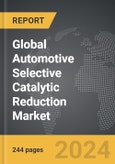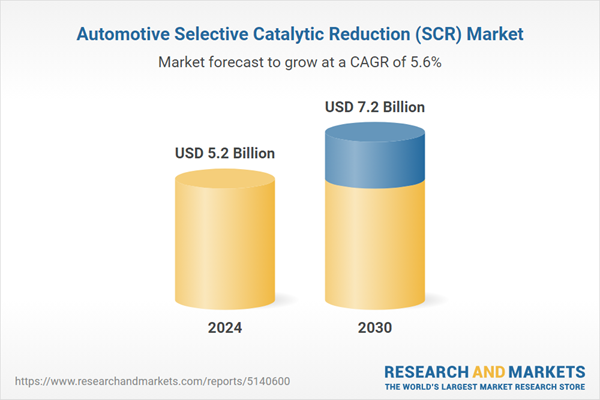The global market for Automotive Selective Catalytic Reduction (SCR) was valued at US$5.2 Billion in 2024 and is projected to reach US$7.2 Billion by 2030, growing at a CAGR of 5.6% from 2024 to 2030. This comprehensive report provides an in-depth analysis of market trends, drivers, and forecasts, helping you make informed business decisions. The report includes the most recent global tariff developments and how they impact the Automotive Selective Catalytic Reduction (SCR) market.
Segments: Catalyst Type (Copper Zeolite, Iron Zeolite, Other Catalyst Types); Catalyst Structure (Honeycomb, Other Catalyst Structures); End-Use (Passenger Cars, Commercial Vehicles).
Geographic Regions/Countries: World; United States; Canada; Japan; China; Europe (France; Germany; Italy; United Kingdom; Spain; Russia; and Rest of Europe); Asia-Pacific (Australia; India; South Korea; and Rest of Asia-Pacific); Latin America (Argentina; Brazil; Mexico; and Rest of Latin America); Middle East (Iran; Israel; Saudi Arabia; United Arab Emirates; and Rest of Middle East); and Africa.
The analysts continuously track trade developments worldwide, drawing insights from leading global economists and over 200 industry and policy institutions, including think tanks, trade organizations, and national economic advisory bodies. This intelligence is integrated into forecasting models to provide timely, data-driven analysis of emerging risks and opportunities.
Global Automotive Selective Catalytic Reduction (SCR) Market - Key Trends and Drivers Summarized
How Has Selective Catalytic Reduction Revolutionized Emission Control in Automobiles?
Selective Catalytic Reduction (SCR) has emerged as a pivotal technology in the battle against vehicular emissions, transforming the way automotive manufacturers address environmental regulations. Introduced as a solution to meet stringent nitrogen oxide (NOx) emission standards, SCR technology utilizes a urea-based fluid, commonly known as Diesel Exhaust Fluid (DEF), which is injected into the exhaust stream of diesel engines. This fluid reacts with NOx gases in the presence of a catalyst, converting them into harmless nitrogen and water vapor. The adoption of SCR systems has been particularly crucial in reducing the environmental impact of heavy-duty diesel vehicles, such as trucks and buses, which are significant contributors to air pollution. Over the years, SCR technology has been fine-tuned and optimized, resulting in systems that not only meet but exceed regulatory requirements, positioning it as a preferred choice for automakers globally. The success of SCR in reducing NOx emissions has also played a critical role in helping manufacturers comply with Euro 6 and other similar stringent emission standards worldwide.Why Is SCR Technology Gaining Traction in the Automotive Industry?
The growing adoption of SCR technology in the automotive industry can be attributed to several compelling factors. Firstly, the ability of SCR systems to significantly reduce NOx emissions without compromising engine performance has made it an attractive option for manufacturers. Unlike other emission control technologies that may lead to a decrease in fuel efficiency or engine power, SCR systems work in harmony with diesel engines, ensuring optimal performance while minimizing environmental impact. Additionally, the flexibility of SCR technology, which can be easily integrated into existing vehicle platforms, has facilitated its widespread acceptance across different vehicle segments, from passenger cars to heavy-duty trucks. Moreover, the increasing global emphasis on reducing greenhouse gas emissions has further accelerated the demand for SCR systems, as they enable automakers to meet both current and future emission regulations. The technology’s scalability and adaptability have also made it a viable solution for various engine sizes and configurations, allowing manufacturers to achieve compliance without extensive redesigns or overhauls of their existing engine technologies.What Are the Technological Innovations Driving SCR System Efficiency?
Technological advancements have been a key driver in enhancing the efficiency and effectiveness of SCR systems in the automotive sector. Recent innovations have focused on improving the precision of DEF injection, optimizing catalyst performance, and reducing system complexity. For instance, the development of advanced dosing systems has allowed for more accurate control of DEF injection, ensuring that the optimal amount is used to neutralize NOx emissions without wastage. This not only enhances the system's efficiency but also reduces operating costs for end-users. Additionally, advancements in catalyst materials have led to more durable and thermally stable SCR systems, capable of withstanding the harsh operating conditions of modern diesel engines. Another significant innovation is the integration of SCR systems with onboard diagnostics (OBD) and real-time monitoring technologies, which provide continuous feedback on system performance and allow for proactive maintenance. These technological enhancements have not only improved the overall effectiveness of SCR systems but have also made them more reliable and user-friendly, further driving their adoption in the automotive industry.What Is Driving the Growth in the Automotive SCR Market?
The growth in the automotive SCR market is driven by several factors that reflect broader trends in the automotive industry and regulatory landscape. One of the primary drivers is the tightening of global emission standards, particularly in regions like Europe, North America, and China, where governments are enforcing stricter NOx limits. This regulatory pressure has compelled automotive manufacturers to adopt SCR technology as a means of compliance, especially for diesel-powered vehicles. Additionally, the increasing demand for fuel-efficient vehicles, driven by rising fuel prices and consumer awareness of environmental issues, has bolstered the adoption of SCR systems, which help maintain fuel efficiency while reducing emissions. The shift towards cleaner, more sustainable transportation solutions, including the growing market for commercial vehicles and public transportation, has further expanded the addressable market for SCR technology. Furthermore, advancements in SCR system integration, such as the development of compact and lightweight designs that can be seamlessly incorporated into various vehicle platforms, have made it easier for manufacturers to deploy these systems across their product lines. The rise of hybrid and electric vehicles, while presenting a challenge, also offers opportunities for SCR systems to be used in hybrid diesel configurations, ensuring that these vehicles meet the stringent emission standards required in urban and environmentally sensitive areas.Report Scope
The report analyzes the Automotive Selective Catalytic Reduction (SCR) market, presented in terms of units. The analysis covers the key segments and geographic regions outlined below.Segments: Catalyst Type (Copper Zeolite, Iron Zeolite, Other Catalyst Types); Catalyst Structure (Honeycomb, Other Catalyst Structures); End-Use (Passenger Cars, Commercial Vehicles).
Geographic Regions/Countries: World; United States; Canada; Japan; China; Europe (France; Germany; Italy; United Kingdom; Spain; Russia; and Rest of Europe); Asia-Pacific (Australia; India; South Korea; and Rest of Asia-Pacific); Latin America (Argentina; Brazil; Mexico; and Rest of Latin America); Middle East (Iran; Israel; Saudi Arabia; United Arab Emirates; and Rest of Middle East); and Africa.
Key Insights:
- Market Growth: Understand the significant growth trajectory of the Copper Zeolite segment, which is expected to reach US$3.7 Billion by 2030 with a CAGR of a 5.9%. The Iron Zeolite segment is also set to grow at 5.4% CAGR over the analysis period.
- Regional Analysis: Gain insights into the U.S. market, valued at $1.4 Billion in 2024, and China, forecasted to grow at an impressive 8.5% CAGR to reach $1.7 Billion by 2030. Discover growth trends in other key regions, including Japan, Canada, Germany, and the Asia-Pacific.
Why You Should Buy This Report:
- Detailed Market Analysis: Access a thorough analysis of the Global Automotive Selective Catalytic Reduction (SCR) Market, covering all major geographic regions and market segments.
- Competitive Insights: Get an overview of the competitive landscape, including the market presence of major players across different geographies.
- Future Trends and Drivers: Understand the key trends and drivers shaping the future of the Global Automotive Selective Catalytic Reduction (SCR) Market.
- Actionable Insights: Benefit from actionable insights that can help you identify new revenue opportunities and make strategic business decisions.
Key Questions Answered:
- How is the Global Automotive Selective Catalytic Reduction (SCR) Market expected to evolve by 2030?
- What are the main drivers and restraints affecting the market?
- Which market segments will grow the most over the forecast period?
- How will market shares for different regions and segments change by 2030?
- Who are the leading players in the market, and what are their prospects?
Report Features:
- Comprehensive Market Data: Independent analysis of annual sales and market forecasts in US$ Million from 2024 to 2030.
- In-Depth Regional Analysis: Detailed insights into key markets, including the U.S., China, Japan, Canada, Europe, Asia-Pacific, Latin America, Middle East, and Africa.
- Company Profiles: Coverage of players such as BASF SE, BMW Group (Bayerische Motoren Werke AG), Bosal Group, Citroen, Cormetech, Inc. and more.
- Complimentary Updates: Receive free report updates for one year to keep you informed of the latest market developments.
Some of the 42 companies featured in this Automotive Selective Catalytic Reduction (SCR) market report include:
- BASF SE
- BMW Group (Bayerische Motoren Werke AG)
- Bosal Group
- Citroen
- Cormetech, Inc.
- FORVIA Group
- Johnson Matthey PLC
- Renault Group
- Roechling Se Co. KG
- Tenneco, Inc.
Tariff Impact Analysis: Key Insights for 2025
Global tariff negotiations across 180+ countries are reshaping supply chains, costs, and competitiveness. This report reflects the latest developments as of April 2025 and incorporates forward-looking insights into the market outlook.The analysts continuously track trade developments worldwide, drawing insights from leading global economists and over 200 industry and policy institutions, including think tanks, trade organizations, and national economic advisory bodies. This intelligence is integrated into forecasting models to provide timely, data-driven analysis of emerging risks and opportunities.
What’s Included in This Edition:
- Tariff-adjusted market forecasts by region and segment
- Analysis of cost and supply chain implications by sourcing and trade exposure
- Strategic insights into geographic shifts
Buyers receive a free July 2025 update with:
- Finalized tariff impacts and new trade agreement effects
- Updated projections reflecting global sourcing and cost shifts
- Expanded country-specific coverage across the industry
Table of Contents
I. METHODOLOGYII. EXECUTIVE SUMMARY2. FOCUS ON SELECT PLAYERSIII. MARKET ANALYSISCANADAITALYSPAINRUSSIAREST OF EUROPESOUTH KOREAREST OF ASIA-PACIFICARGENTINABRAZILMEXICOREST OF LATIN AMERICAIRANISRAELSAUDI ARABIAUNITED ARAB EMIRATESREST OF MIDDLE EASTIV. COMPETITION
1. MARKET OVERVIEW
3. MARKET TRENDS & DRIVERS
4. GLOBAL MARKET PERSPECTIVE
UNITED STATES
JAPAN
CHINA
EUROPE
FRANCE
GERMANY
UNITED KINGDOM
ASIA-PACIFIC
AUSTRALIA
INDIA
LATIN AMERICA
MIDDLE EAST
AFRICA
Companies Mentioned (Partial List)
A selection of companies mentioned in this report includes, but is not limited to:
- BASF SE
- BMW Group (Bayerische Motoren Werke AG)
- Bosal Group
- Citroen
- Cormetech, Inc.
- FORVIA Group
- Johnson Matthey PLC
- Renault Group
- Roechling Se Co. KG
- Tenneco, Inc.
Table Information
| Report Attribute | Details |
|---|---|
| No. of Pages | 244 |
| Published | April 2025 |
| Forecast Period | 2024 - 2030 |
| Estimated Market Value ( USD | $ 5.2 Billion |
| Forecasted Market Value ( USD | $ 7.2 Billion |
| Compound Annual Growth Rate | 5.6% |
| Regions Covered | Global |









